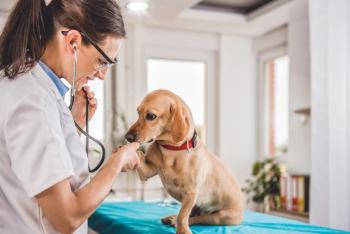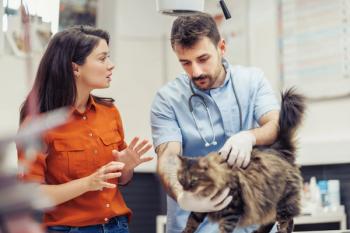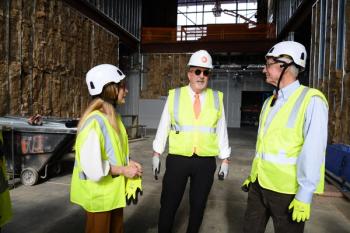
Is it time for you to haul equine patients in?
If the day-to-day struggles of an ambulatory equine practice are wearing you down, it may be time to consider building, buying, or renting a haul-in facility.
Ever since the first equine veterinarian embarked on a farm call, two questions have plagued the industry:
- How do we capture fees relative to the time and expense of travel?
- How do we predict the time involved with that travel and its subsequent impact on the daily schedule?
Rather than suffering through a lot of trial and error, the simplest solution that addresses both of those concerns is to put the responsibility on the client by encouraging haul-in appointments. While it's unlikely that equine practice will fully transition away from ambulatory services, using a haul-in facility offers an alternative that benefits the client-and your practice-in a number of ways.
Most veterinarians say that the fee for their farm or house calls has never, and probably never will, reflect the actual travel time or fuel costs, not to mention other vehicle-related expenses. Many have simply stuck with a fee that they implemented years ago-one that has risen unremarkably over time-indicating a general unwillingness to follow suit with the rest of the world and pass along seasonal and semi-permanent increases in fuel (that's another topic altogether). No doubt, picking a bare piece of land and scheduling a day's worth of calls that come to you would be a sharp improvement economically, but with just a little investment the concept can provide benefits that go beyond financial. Consider the components and benefits of a successful facility.
Shelter
Being able to work on a patient under shelter and with protection from wind and rain is a luxury that doesn't exist on some farm calls. A two- or three-sided pole barn can be adapted easily to create a comfortable workspace, and those who want to make a more significant investment might consider one or more stalls or a fully enclosed facility with temperature controls.
Lighting and electricity
Extension cords, mobile vehicles equipped with outlets, and headlamps provide the minimum needs in the field, but nothing compares with having the power you need, as well as outlets, at your immediate disposal. Headlamps may still rule even in a haul-in scenario, but having the ability to create a broader field of illumination is helpful. Depending on the condition, creating a darkened environment to focus a small amount of light in a specific area can also enhance diagnostic ability.
Footing
Unfortunately, not every horse owner can afford a stall barn with an improved work area, and conducting examinations and procedures on uneven ground can create safety risks for the horse, the client, and the veterinarian. What veterinarian would rather work in mud or pastures when he or she could enjoy a clean, paved surface? A round pen with a floor of the veterinarian's preferred surface material creates an ideal area to lunge a patient and will aid in lameness diagnoses.
Stocks and palpation chute
Experienced practitioners are able to use whatever is available in the field to avoid being kicked during a rectal palpation, but a well-built stocks system can provide confidence and protection during risky procedures. Built correctly, it can also provide a means to elevate a horse's head while under sedation for dental work.
Access to staff
While many equine practitioners have conceded that they need help during calls, many prefer to practice alone. For mixed animal practitioners, locating a haul-in facility at the same location as your small animal clinic allows the dual use of staff members when needed. Having an extra set of hands to assist with radiographs or enlisting a staff member to complete Coggins forms can improve efficiency and productivity.
Radiography processing
For those equine veterinarians with digital radiography systems, disregard this section, but if you still use traditional film-based cassettes or use a computed radiography system, being close to the processing unit is invaluable. The ability to quickly identify and retake a bad shot can save time for another farm call, and the ability to have the owner view the films in person is an option that just doesn't exist for those without a digital radiography system.
Availability of supplies
Whether you have a mixed practice with a small animal clinic or simply a storage area at your haul-in facility, having supplies at hand will reduce the number of trips to a client's barn or the need for them to travel a second time to you.
Scheduling and compensation
While the components of a successful haul-in facility certainly create a compelling case in its favor, nothing compares with the time and fuel savings of having a haul-in schedule. In ambulatory practice, depending on your coverage area, it may be realistic to plan on four to six appointments per day. If your average invoice amount is $200, that's $800 to $1,200 per day that you're bringing in. With a properly scheduled day of haul-in appointments, it's possible to see double that many.
Average invoice amounts for haul-in cases may be slightly lower because they lack a house call charge, but you'll more than make up for it with a higher volume of invoices, saved fuel costs, and no drive time. If your average invoice drops to $150 but you see 12 clients instead of six, that's an increase of $600 per day-$150,000 per year. And that's not factoring in the savings of $50 per day in fuel expenses.
Given the current state of our economy, and specifically the equine industry, clients are more than happy to save money. The clients who own a trailer will jump at the chance to save $50 on a call, and many will consider that savings when they're deciding on the recommendations you make. Many practitioners will see ancillary services quickly replace the lost house call revenue, resulting in fairly stable average invoice amounts.
The flip side
Despite the many benefits of a haul-in facility, there are drawbacks as well. Just as ambulatory practitioners struggle with traffic and unpredictable travel time, so will the clients who are driving to you. Ambulatory practitioners who typically have a full day of appointments and driving will find it difficult to wait around for the client who is always late or the one who's coming in for the first time and gets lost.
Failure to provide a spacious entry and parking area can result in a lineup of horse trailers that stretches from your facility to who knows where. Some practitioners elect to have a circular turnaround that allows trailers to come in and go back out, but clients who are early or late can make it difficult to see patients according to schedule as opposed to when they arrive. A large parking area with multiple head first style parking spaces will prevent “out of order” appointments and keep your entry and other parking areas free.
Overall, there are a number of benefits to using a haul-in facility, but it might not be the best solution for everyone. Do an honest evaluation of your work needs and finances before haulin' into this option for your practice.
Newsletter
From exam room tips to practice management insights, get trusted veterinary news delivered straight to your inbox—subscribe to dvm360.




